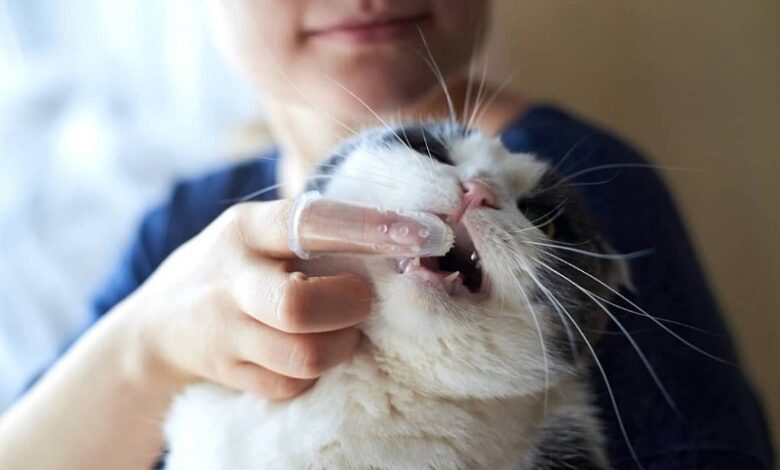
How to Brush Your Cat’s Teeth
Does your feline’s breath smell like an abandoned fish market? Jokes aside, keeping your pet’s gums and teeth clean and healthy can help to prevent periodontal disease and other health problems. Learning to brush your kitten’s teeth is just one step to preventing these health problems before they start.
Gather Your Supplies
- Soft-bristled brush for kittens or finger toothbrushes.
- Veterinary toothpaste for felines. (Please note that human toothpaste can be unsuitable for cats!)
- Soft gauze sponge or cloth.
- Please ask your veterinarian for recommendations on your cat treatment, if you are unsure where to find these supplies.
How To Brush Your Felines Teeth
Remember, patience is vital – don’t force the issue. Keep this simple, and you will be surprised by how successful you can be!
Begin by Gently Handling and Manipulating Your Kittens Mouth
- If your feline is calm, start with affectionate touches and give her treats.
- Begin to touch or manipulate your cat’s mouth gently. Give her immediate rewards if your cat is quiet, responds to requests, and allows you to control her mouth. If your cat resists, take the treats away and stop.
- Slowly advance from moving your cat’s lips with your fingers to running your fingers along her gums and teeth. Once your feline is comfortable with your fingers in her mouth, try to put a soft, moist gauze sponge around your finger and move it along her teeth.
- It will likely take several trials to work up to this point. Give treats throughout and end the session if your kitten resists. Try the next day again.
Use Toothpaste
- Once your kitten is comfortable with the sponge or cloth along her teeth, add veterinary-recommended toothpaste or gel to the gauze sponge.
- Keep up the praise and treats! Make it enjoyable!
Introduce The Toothbrush
- Bring out the toothbrush. Put it under your cat’s lips and gently work it around. Pick a brush that is easy for you to use.
- If your feline likes the toothpaste, have her lick it off the brush. Don’t forget to praise and reward her with treats!
Start Brushing
- Focus on your cat’s gum line and use the toothbrush in a circular motion.
- Initially, please focus on the outside surfaces of the cat’s teeth, under her lips. Eventually, brush your way up to all of your feline’s teeth. Spend about 1-3 minutes brushing her entire mouth once daily.
Teaching Your Kitten To Be Comfortable With Toothbrushing
The idea is to brush all of the outside surfaces of your feline’s teeth once a day, using a soft-bristled brush and veterinary toothpaste. It may take weeks for your cat to become comfortable brushing her teeth. Be consistent with your daily routine and keep this a positive experience for you and your feline.
Select your Time Felines to respond to routine, so be consistent with the time you brush your teeth every day. Choose a time of day that is quiet and when your kitten is usually hungry – not the first thing after you get back from work.
How Often To Brush Your Cat’s Teeth
Ideally, you’d brush your cat’s teeth daily and have a professional dental cat treatment and cleansing once every year at your veterinarian. If your feline’s gums and teeth are in bad shape or extra sensitive and painful (and if they haven’t had a deep cleaning in a while), opt for professional cleaning at your vet’s office.
Choose The Reward
Pick a treat that motivates your kitten – a food she loves or something else that makes your cat happy (i.e., petting, playing, or brushing). If your feline thinks this is a fun activity involving rewards, she will continue to play. If you are giving food, have tiny bits of it available.
Set The Surroundings And Keep It Positive
Place your feline on an oversized chair, couch, or lap next to you. Use a gentle, calm tone of voice and maintain a positive attitude and manner. Your kitten will sense and respond to any anxiety you may be feeling. Remember to have rational expectations about how fast you progress and be persistent.
It is recommended to buy cat insurance as, by three years, most felines will have mild-to-moderate dental issues requiring an extensive oral examination and treatment performed under anesthesia. Proactive dental care can decrease the risk of other medical conditions (like heart disease, sinus infections, and renal disease) and contribute to a long life together with your cat insurance.





